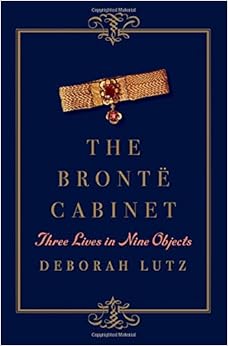The Brontë Cabinet: Three Lives in Nine Objects (2015) W.W. Norton
English professor Deborah Lutz applies contextual historical material culture to illuminate the lives and works of the Brontës via, as the title so speaks, nine material objects that have survived since their deaths.
The chapter titled "Death Made Material" centers the amethyst bracelet that features on the book's jacket, worn by Charlotte, made from "the entwined hair of Emily and Anne." The bracelet was made most probably by a professional "hairworker," a profession that employed thousands in 1830's and 40's Britain.
Mourning jewelry as part of the grieving process was only part of what hairworkers provided, but objects incorporating a beloved dead person's hair was the largest part of the profession.
Manuals for how people could and prepare the hair in their own homes and incorporate it into other objects, such as keepsake portraits of the dearly departed, drawn landscapes and tableaus incorporating graveyards and other melancholy signatures were available and popular.
As would be the case with this sad though very talented family, much of The Brontë Cabinet deals with illness, death, grief and mourning. However it also retrieves the economic and social constructs around the matters of women who write professionally, household pets and genteel women's letter writing -- which latter brings us to the development and history of mail, the penny post, Valentines and other matters.
The author, not needing to, doesn't mention that as much as hairworkers, letter writing and the post office are dead letters now. That, though not expressed, says more about how distant in time now the Brontës are, than anything else. Yet their work endures, and we remain as fascinated by anything that had physical contact with this family as the celebrity seekers in their own time, As the author does point out this determination to own something of figures that impact their fans is as old as saints' relics and this is anything but a dead matter.
Often, as with many Brontë collections the relics need not even be authentic. What matters is what the possessor believes s/he possesses.
Wednesday, August 5, 2015
Reading Wednesday - The Brontë Cabinet: Three Lives in Nine Objects
Subscribe to:
Post Comments (Atom)



No comments:
Post a Comment